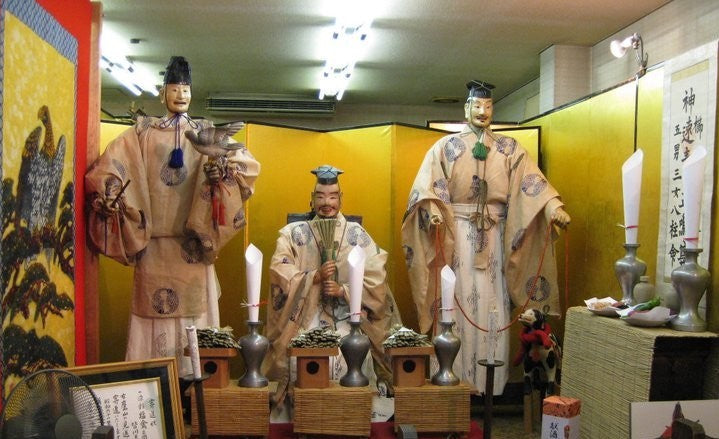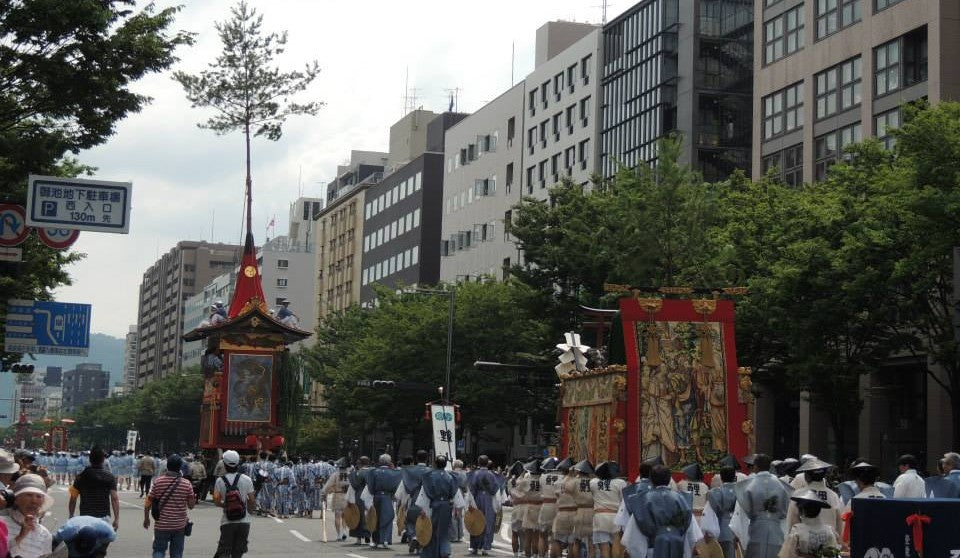Article: Chikiriya and the neighboring float "Takayama"

Chikiriya and the neighboring float "Takayama"
In the busy streets of Koromonotana-cho, Kyoto, where the Chikiriya family mainly prospered, there was the “Takayama” float.

The Gion Matsuri which takes place annually in Kyoto, was cancelled during the Ōnin War (1467-77). Still, before the outbreak of the war, the Takayama float rolled through Kyoto’s streets registered as “Takatsukaiyama.” The Takayama float worshiped three shintai (sacred dolls), the “Takatsukai” (falconer), the “Inutsukai” (dog handler), and the “Taruoi” (person in charge of food).
There are two types of floats rolling through Kyoto’s streets during the Gion Matsuri: “Yama” (mountains) and “Hoko” (spears) floats. On one hand, Hoko are giant floats on wheels with metal ornaments and dominated by a tall wooden central pole or shingi. On the other hand, Yama floats that are less opulent than Hoko and dominated by a pine tree, are known as “moving museum” because of their elaborate decoration featuring sacred dolls of Japanese historian figures. Regardless of these differences, Yama and Hoko floats have the same style and can be easily confused with one another.
When Yama and Hoko are called “hikiyama” (festival floats), the Takayama float is called “kujitorazu”, an enhanced Yamaboko with a fixed position. The Gion Matsuri occurs during the whole month of July, with two main dates, the 17th and 24th of July. Naginata Hoko, the best-known float nationwide which always leads the parade, opens the Saki Matsuri's Yamaboko Junkō (First Float Procession) on the 17th of July, while the Takayama float usually parades on July 24th during the Ato Matsuri's Yamaboko Junkō (Second Float Procession). Yet, it is said that the Takayama float once shared the lead with the Naginata Hoko float.



The Takayama float main platform features the figures of the three deities or shintais. The “Takatsukai” (falconer) is holding a hawk, the “Inutsukai” (dog handler) is leading a dog, and the “Taruoi” (person in charge of food) is carrying on his back a barrel and holding a rice cake wrapped in bamboo leaves in his hands.
In 1826, the Takayama float was strongly damaged by strong wind and rain during the festival parade and could not be included in the Gion Matsuri parade from the following years. Even worse, most of the float was destroyed in a fire in 1864 during the Hamaguri Gate Rebellion or Kinmon incident (Forbidden Gate Incident), a rebellion against the Tokugawa shogunate. Only the heads and the hands of the three shintais (sacred dolls) were missed by the fire.
The remaining objects of worship were decorated and enshrined at a meeting place (kaisho) in Koromonotana-cho and are displayed during the Gion Matsuri ever since. The display of the three sacred dolls called “Imatsuri”, is also known as “Taruoi-yama”, because of the central character carrying on his back a barrel. “Taruoi-yama” can also be pronounced, "Taroyama."



The Takayama float thirteen ornaments (the three heads of the shintais and their storage boxes, the three pairs of hands and their storage boxes, and the four burnt gongs) were designated as Kyoto tangible folk-cultural properties by the Cultural Affairs Agency.
For nearly 50 years, the Gion Matsuri two grand parades had been united as one. But the festival was restored to its former glory in 2014. For the first time in 49 years, the Saki Matsuri was held on July 17th, and the Ato Matsuri on July 24th.
With the revival of the Ato Matsuri in 2014, the group of musicians to play in the orchestras that accompany the Takayama float was reformed and in 2015 the Takayama Preservation Association was founded. Chikiriya has joined and taken an active part to this local initiative that aim to restore and rebuild the Takayama float.
The Takayama float is now due to parade in the 2022 edition of the Gion Matsuri, a first in 196 years.
Takayama Preservation Association Official Home Page (Japanese only)
http://www.takayama.or.jp/
Kyoto Information Center Home Page (Japanese only)
13 pieces of Takayama ornaments (Kyoto tangible folk-cultural properties)
https://www.city.kyoto.lg.jp/bunshi/page/0000039313.html



Leave a comment
This site is protected by hCaptcha and the hCaptcha Privacy Policy and Terms of Service apply.